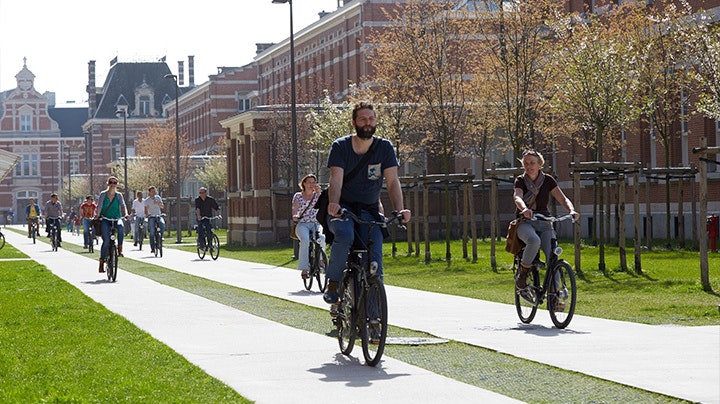Sustainable cities of the future
Publication date 12 August 2019In principle, cars do not belong in big Flemish cities such as Ghent and Antwerp, with their beautiful, historic centres. Yet, in the years following the war, the car became king and exploded in popularity as city centres became increasingly densely populated. This turned historic squares into car parks and swept aside greenery to make way for roaring engines on four wheels. However, over the last few years there has been an overtly palpable pushback to make cities car-free once again. More sustainable mobility plans are being put forward which take away the car’s crown and increasingly make it give way to electric alternatives, pedestrianised zones and cycleways.

As a project developer and inner-city innovator, we too are feeling this shift and engaging with the issue to find a forward-looking alternative approach to mobility. Electric charging points, bicycle storage facilities and car-sharing are just some of the aspects we are using more often in new residential projects. Car-free zones are becoming the norm and one pioneering project par excellence is The Green Quarter - (‘t Groen Kwartier) in Antwerp.
The Green Quarter - (‘t Groen Kwartier) - Farewell, car, king no more
The new neighbourhood of The Green Quarter is completely car-free. We did this deliberately to leave the spirit of the hospital site unspoilt and retain the peace and quiet on the beautiful interior square. You will not find any roaring engines and emissions here, just pedestrians, runners, cyclists and children playing. It has become an oasis of green where peace and quiet and a high quality of life are key. Residents may park a car underground. The entrance to the underground car park is located in one of the neighbouring streets.
Sites like The Green Quarter are highly prized abroad, too. The prestigious British magazine “The Economist” recently called this new neighbourhood the jewel in the crown of Antwerp in the post-car age which we are gradually launching into.
The post-automotive jewel in Antwerp’s crown is the Groen Kwartier, an entirely carless neighbourhood built around the site of a former hospital.
Recent research has also shown that banning cars in The Green Quarter not only resulted in more peace and quiet in the neighbourhood but also effectively created noticeably better air quality than in the big city’s busier surrounding areas.
The lowest NO2 concentrations were identified in low-traffic oases in the city centre such as the city park and the zoo, and the traffic-free Green Quarter (former military hospital) in Berchem.
Added value for people and the environment
Low-traffic residential projects create absolute added value for people and the surroundings. This is what we stand for and strive for as a project developer. Projects such as Leanderhof in Zwevegem, De Nieuwe Dokken in Ghent and Handbogenhof in Lier banish cars to underground car parks, creating more free space above ground for green parks, peaceful pedestrianised zones or even a collective vegetable garden. As creators of triple-A places we make every project a place with a story that is ready for the way of living of the future.
Sources:
https://www.economist.com/euro...
https://ringland.be/academie/c...